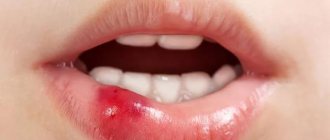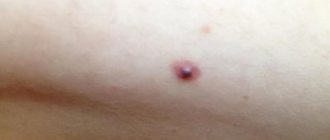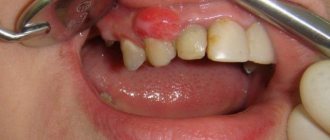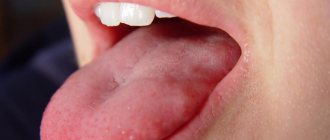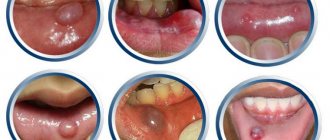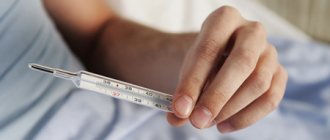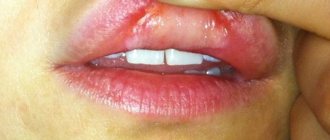What is a sore on the lip
If discomfort prevails in the corners of the mouth or on the surface of the lips, accompanied by itching and burning, this means that ulcers will soon form. This is the result of increased activity of the herpes virus, which unexpectedly became active, for example, against the background of weak immunity or after long-term antibacterial therapy. It is difficult to cope with the causative agent of the rash, and it is impossible to completely remove it from the body. A person can live with the herpes virus all his life without relapses if he constantly adheres to medical recommendations.
What to do if sores appear on the corners of your lips and do not go away
Seizures in the corners of the mouth can appear in every person, but in the absence of aggravating factors and with proper treatment, they disappear within 1-3 weeks.
If angulitis continues for more than a month, this is a serious reason to consult a doctor and undergo appropriate diagnostics:
- scraping from affected areas to check for candidiasis;
- blood sampling for sugar, hemoglobin and leukocyte concentrations;
- Additionally, it is necessary to undergo testing for syphilis, HIV and other infections.
Based on the diagnostic results, appropriate therapy is prescribed, which includes external and internal medications, vitamin therapy, proper nutrition and means to enhance immunity.
- Streptococcal angulitis is treated with antibacterial and anti-inflammatory ointments - the most common include: Tetracycline, Trimistin, Miramistin.
- The disease caused by the activity of fungi requires special therapy - the most commonly used creams are Clotrimazole and Lamisil.
- If the nature of angular stomatitis is not determined, you can use the following drugs: Metrogyl Denta, Fukortsin, Stomatidine, which have antibacterial, antifungal and antiseptic properties.
- In difficult cases, it is necessary to use ointments containing antibiotics or take antimicrobial drugs orally.
Clotrimazole as an ointment
Along with the use of external remedies, you should take vitamin complexes and increase the amount of nutrients in your diet - eat fresh vegetables and fruits (preferably seasonal), herbs, dairy products, lean meat, liver, bran, seafood. In addition, you should spend time in the fresh air as often as possible, strengthen your body and engage in light physical activity.
When creating a menu, do not forget that most vitamins are destroyed by prolonged heat treatment and improper storage of foods, so it is better to eat vegetables boiled or steamed, not frozen or exposed to sunlight.
Types of disease and localization of wounds
If sores appear on the lips, this is not an independent disease, but only an unpleasant symptom, which is complemented by unpleasant itching, severe burning and internal discomfort. This clinical picture may indicate such unpleasant diseases as:
- stomatitis;
- herpes;
- jam;
- mechanical or chemical injury to the mucous membrane.
Depending on the diagnosis, the localization of the pathological focus has its own significant differences. For example, when jamming occurs exclusively in the corners of the lips, cracks first form, which over time are modified into ulcers. Stomatitis affects the inner surface of the lips, and the white sores continue to hurt very much. With herpes, the foci of pathology are more extensive, starting from the lips and oral cavity, spreading to the nasal mucosa and the skin of the face. The external manifestations of the disease give rise to disturbing thoughts, but the sores inside remain for a long time without medical attention.
Diagnostics
If ulcers constantly appear in the corners of the lips, and self-treatment is ineffective, the dentist conducts the following diagnostics:
- interviewing the patient, possible symptoms, bad habits, allergic manifestations, circumstances of the onset of the disease;
- examination and assessment of the condition of the skin, teeth, oral cavity and lymph nodes;
- cytological and bacterial examination of ulcers (identifying the causes of erosion);
- serological and immunological examination of the causes (syphilis and HIV infections are excluded);
- recommendations from other experts.
Symptoms
Inflammation on the lip, externally and internally, begins with an acute attack of pain, which is felt locally and produces separate foci - ulcers. Such sores are round in shape, predominantly yellow or white, with liquid contents inside. If an ulcer is injured, the mucous membrane begins to hurt greatly, and attacks intensify during meals in the presence of hot, spicy and salty foods. With this type of damage, the symptoms are as follows, depending on the etiology of the pathological process:
- With stomatitis: white plaque with a gray tint in the oral cavity, increased body temperature, lack of appetite, sudden weight loss, pain when chewing food, irritation of the mucous membrane.
- In case of seizures: the sores are located in the corners of the mouth, after a few days they form a crust, after 1 - 2 weeks they disappear, causing discomfort.
- For herpes: the symptoms are similar to those of herpes, only the incubation period is longer, supplemented by swelling of the mucous membrane, symptoms of redness and increased sensitivity, and blisters on the mucous membrane.
Localization Features
Herpes can be localized in a certain place: the lip on the outer and inner sides. This can be seen in the photo.
On the inside of the lip
The inner part of the mucous membrane becomes covered with an ulcer and can fester due to prolonged radiation sessions or chemotherapy. This vesicular abscess is yellow in color and has an oval or circle shape. Its size is approximately 1 centimeter in diameter.
On the inside of the lip, a white patch is surrounded by reddish skin. The virus can form several sores at the same time. The maximum number is 5. The disease disappears without a trace within a week.
This phenomenon is often observed when the mucous membrane is infected with yeast fungi of the genus Candida. As a result of candidiasis (thrush), inflammation of the oral cavity develops. Children are at the main risk group for stomatitis. Even a newborn can become infected through contact with a sick adult.
As the child grows up, he begins to pull various objects into the oral cavity. They contain dirt; subsequently, a darkening with a grayish-white tint in the form of scales becomes noticeable in the corner of the lip, which can hurt.
At the initial stages, the film thickens, a wound may pop out, which soon begins to grow and tear; inside it contains transparent exudate (mucus released due to inflammation). Treat the surface of the dental ulcer with nystatin ointment, Clotrimazole or Fluconazole, and apply a thin layer for several days.
On the outside
Due to provoking factors, the upper and lower areas of the lip are susceptible to the appearance of white spots. Infection begins with the skin tingling and forming a red area. The incubation period is 2-3 days. After this, a white bubble should appear that contains pus. Over time, the abscess matures and bursts. This condition may be accompanied by chills and elevated temperature. To get rid of poor health, it is recommended to take an anti-inflammatory medicine (Ibuprofen, Nimesulide). White sores are very contagious; in addition, they can appear in the chin and nose area.
Ulcerative rashes on the lower lip may indicate a cancerous tumor. According to statistics, approximately 1.5% of women have this pathology. The key factor is the age factor.
The cancerous type of ulcer is characterized by compaction in the place where the soft skin was located. This disease has an ICD 10 code “Other malignant skin tumors” in the International Classifier. If the pathology is not treated within a month, then to further determine the cancer, a skin puncture is prescribed, for which a special instrument is used.
A white sore under the lower lip manifests itself in the form of irritation from exposure to wind, which subsequently becomes crusted. Typically, these sores do not itch and are not contagious unless touched.
Traces of herpes may appear as sticking in the corners of the mouth due to careless biting. This phenomenon is accompanied by pustules (aphthae), skin rashes and discomfort. It all starts with redness, turning into wounds and erosion. Seizures interfere with talking, eating, and using cosmetics. If timely treatment is not carried out, there is a danger of the formation of bleeding ulcers of a dark color.
The trophic or chronic nature of aphtha does not exclude the development of syphilis. This diagnosis can be confirmed by taking a blood test from a vein and undergoing an examination.
Sores on a child's lips
The healing process of ulcers is long, especially when it comes to young patients. It is important to avoid irritation and injury to foci of pathology, which is difficult to achieve in childhood. In case of infection, the weeping wound hurts and oozes and does not heal for a long time. The child behaves nervously and irritably and categorically refuses to eat. Among other symptoms of such diseases, doctors identify:
- the appearance of pus;
- visible redness of pathological foci;
- formation of an abscess on the lip;
- signs of the appearance of bubbles that merge into one spot;
- hyperemia of the oral mucosa.
How to treat seizures during pregnancy
During pregnancy, women's immunity is significantly reduced, and seizures are a common occurrence. The difficulty of treating ulcers lies in the fact that most medications are prohibited for expectant mothers, so it is best to use folk remedies:
- apply lotions of essential and vegetable oils (olive, rosehip, tea tree) to the affected areas;
- mix cottage cheese and freshly squeezed carrot juice in equal proportions, lubricate the resulting mixture with the mixture several times during the day;
- chop the apple, add a little butter to the pulp, make lotions 3-4 times a day;
- take 10 g of propolis and 100 g of butter, melt in a water bath, soak a cotton swab in the resulting broth and apply to the corners of your lips.
If seizures do not go away within 1-2 weeks, you should consult a doctor - the diseases that cause them can seriously harm the child.
Causes
Even a sore on the inside of the lip can be easily detected by the unpleasant symptoms and painful sensations the patient feels. With such complaints, you should immediately contact your doctor, who must first determine the etiology of the pathological process. The main reasons for the appearance of ulcers on the lips are as follows:
- herpes;
- burn or mechanical injury to the mucous membrane;
- internal diseases.
Factors predisposing to the disease are the following clinical pictures and circumstances:
- weakened immunity;
- prolonged hypothermia of the body;
- exposure to toxic, toxic substances;
- failure to comply with personal hygiene rules;
- mechanical, chemical injuries.
Seizures
If an acute deficiency of vitamin B2 predominates in the body, this is a favorable condition for the formation of seizures, especially in childhood. Sores in the corners of the lips are located and are distinguished by their soreness and internal discomfort. The disease must be treated under strict medical supervision with the participation of local drugs with a pronounced bactericidal, anti-inflammatory, and regenerating effect. The main causes of the disease:
- mucosal injuries;
- microcracks on the lips;
- addition of a secondary infection.
Herpes
This is an infectious disease that is considered incurable. People with herpes can live for a decade without even suspecting the presence of a pathogenic infection in the body. They learn about it only against the background of weakened immunity, when bubbles first appear in the mouth, which are then modified into ulcers, accompanied by severe pain. Herpes in the corners of the lips appears extremely rarely, affecting more extensive surfaces for relapse. Here are other factors predisposing to exacerbation:
- antibacterial therapy;
- environmental, social and everyday factors;
- chronic infections.
Stomatitis
If the mucous membrane of the oral cavity is “surrounded” by a white coating, these are definitely signs of stomatitis, which is also popularly called thrush. The characteristic disease is a consequence of the pathogenic effects of a number of bacteria, viruses, and infectious disease agents, and the factors predisposing to relapse are as follows:
- unbalanced diet;
- mucosal injuries;
- failure to comply with personal hygiene rules;
- excessive dental hygiene;
- presence of bad habits;
- diseases of the digestive system;
- weakened immunity.
Prevention
As practice shows, it is better to prevent any disease than to treat it later, the same with ulcers:
- While eating, chew your food thoroughly to avoid damaging your gums and mucous membranes of your lips.
- Contact only those dentists who have proven themselves on the positive side and have good reviews. The specialist will thoroughly disinfect all instruments, and the likelihood of mechanical damage in the oral cavity will be reduced - the specialist’s experience plays a role.
- Pay attention to the composition of the toothpaste you use. It should not contain such a component as sodium sulfate.
- Avoid stressful situations.
- The appearance of ulcers can signal a hormonal imbalance in the body.
- Ulcers can be caused by an allergic reaction to a food or drug. Be attentive to your body.
- Weakened immunity.
- Lack of iron in the body.
- Disruption of the gastrointestinal tract.
- Menstruation in women can also cause ulcers.
As soon as you notice that ulcers have appeared in your mouth, the first thing to do is stop eating solid foods, which are difficult to chew and may pose a risk of choking.
When brushing your teeth, take your time. Do this carefully. Until the ulcers heal, avoid sour and spicy foods.
How to treat a sore on the lip
Ulcers can be treated using official and alternative methods, but it is important to follow the rules of hygiene and asepsis (to avoid secondary infections). For example, to eliminate herpes, it is better for patients to use Acyclovir ointment, and for stomatitis - chamomile decoction and soda composition. Other medical recommendations for sores in the lip area are presented below:
- It is important to exclude fatty, fried, hot, salty and spicy foods from the diet, thereby avoiding irritation of the inflamed mucous membrane.
- It is necessary to observe the rules of personal hygiene, especially when it comes to progressive stomatitis.
- It is necessary to completely abandon bad habits, avoid mechanical and chemical trauma to the mucous membrane.
- It is imperative to carry out conservative therapy with the participation of antiviral agents (for herpes), local antiseptics (for stomatitis), and regenerating creams (for seizures).
- It is necessary to strengthen weak immunity with the participation of multivitamin complexes, natural vitamins, and immunostimulants.
Treatment methods
Ulcers on the lips are treated using traditional and alternative methods, not forgetting to maintain hygiene and carry out antiseptic treatment. This will avoid the addition of a secondary infection.
For herpes, Acyclovir is prescribed - ointment, for stomatitis - soda solution, infusion of chamomile flowers. This is not the final stage of treatment; a number of additional measures will be required. Doctors give a number of recommendations on how to cure lip ulcers:
- remove fried, spicy, salty, spices from the menu. This will prevent irritation of the mucous membrane, which is already inflamed,
- observe hygiene standards, especially if the child has stomatitis,
- it is advisable to avoid injury to the ulcers,
- use antiviral drugs for herpes,
- treat stomatitis with antiseptics,
- Regenerating ointments are prescribed for this.
If you have a weakened immune system, you need to take a complex of vitamins that can increase the body's defenses.
There are a number of other recommendations that will help cure troublesome sores in the mouth and outside:
- apply hygienic lipstick or thermal water. It is important to avoid drying out the mucous membranes; for this purpose, irrigate or lubricate your lips many times a day, the course lasts until recovery,
- oil containing vitamins E and A helps. This can be petroleum jelly, olive oil, flaxseed oil, as well as avocado oil, rosehip oil,
- Among folk remedies, wax and goose fat, previously melted and cooled to an acceptable temperature, are especially popular,
- Compresses with herbal infusions help a lot. Celandine, sage, chamomile, calendula, string and chamomile will provide a healing effect,
- You can soften the crust of the ulcer with butter and honey. This will prevent new wounds,
- The plant juice is used to lubricate sores. For example, squeeze Kalanchoe, buttercup, celandine, plantain. Garlic juice should be used with caution as it can burn the baby's delicate skin.
- Tea tree oil is good to use for sore lips - you need to moisten a cotton swab with this oil and apply it to the sore in the morning and evening.
If the measures listed above do not help, you need to make a scraping and send it to laboratory technicians to identify the specific pathogen and its resistance. If a fungus is detected, the doctor will prescribe antifungal drugs that are effective against a specific pest.
When the cause of a jam becomes tartar, until it is eliminated, then its consequences will bother the child.
You definitely need to review your diet to replenish it with vitamin B2. It is found in cabbage, nuts, green vegetables, bran, and avocado. They can be given to a child if he has reached a certain age and has no contraindications. Lack of vitamin E can be eliminated by eating nuts, vegetable oils, corn, and oatmeal.
When a baby often has jams in the corners of his mouth, and diagnostics have not revealed any pathologies, it is enough to adjust the diet, introduce fruits and vegetables, and dairy products. Harmful products are excluded. Usually this is enough for the baby to recover.
Folk remedies
Alternative medicine methods for sores in the mouth are reliable and effective, and have virtually no side effects. Here are the most effective recipes for the appearance of ulcers on the oral mucosa:
- In case of seizures, lubricate the wounds with sea buckthorn, linseed or olive oil, which must be preheated to room temperature. The course is until the symptoms disappear.
- You can use fresh plantain juice or pre-chopped garlic. Rub the areas of pathology in the morning and evening until the symptoms disappear.
- Herpes in the corners of the lips can be removed with honey; it is necessary to lubricate the sores in the morning and evening until the signs of the disease disappear. For treatment, you can choose calendula tincture.
Therapy rules
If a red or white sore appears on the upper or lower lip, on the inside of the lip, how to treat such a disease? You can help your baby when sores appear with medications selected by a specialist. Folk remedies can be auxiliary methods. All treatment methods for children suffering from ulcers are aimed at relieving inflammation, anesthetizing and healing the wound. For this purpose, local antiseptics, analgesics, and antibacterial drugs are used. They must be prescribed by a doctor. It is better not to self-treat, since only a specialist can accurately determine the cause.
Prevention of sores
To prevent a sore from appearing on your lip, you need to take timely preventive measures to protect your body from pathogenic infections. For example, the extremely undesirable appearance of erosions is facilitated by systematic violation of the rules of personal hygiene, so such an oversight should not be allowed. Other preventive measures are presented below:
- strengthen immunity;
- avoid chronic infections;
- Healthy food;
- to refuse from bad habits;
- avoid injuries to the mucous membrane, microcracks.
Causes of pain
Various factors can lead to sores appearing on the lips of children. The most common:
- deficiency of Lactoflavin, B vitamins. To compensate for the deficiency, you need to enrich your diet with cabbage, peeled rice, leafy vegetables, avocados, bran,
- abuse of sweets, associated lip licking,
- untimely, improper oral hygiene, ignoring visits to the dentist,
- stressful situations, nervous overstrain, lack of positive emotions,
- E. coli, when its quantity suddenly exceeds the permissible norms,
- excessive release of toxins by the body,
- problems with the functioning of the gastrointestinal tract, metabolism,
- iron deficiency,
- allergies from sun rays,
- anemia,
- general use of personal hygiene items.
What to do for a lacerated lip?
A labral laceration is an injury to soft tissues with a violation of their integrity, which is characterized by bleeding, pain and separation of the edges. The danger of the wound is that in the absence of qualified assistance, the damaged tissues grow together chaotically, forming a scar. This reduces the sensitivity of the lips, presenting an aesthetic problem.
Lip laceration: first aid
First aid is provided in the following order:
- To stop the bleeding - cold is applied to the lip, after which hemostatic agents are applied to reduce bleeding. It is recommended to treat the wound with hydrogen peroxide to prevent the inflammatory process from occurring.
- Reassure the person and record the time of the wound - with large blood losses, hemorrhagic and painful shock can develop, so before arriving at the hospital, they talk with the victim and maintain contact.
- To anesthetize a wound - you can give a person any analgesic (Analgin, Nurofen), which will reduce painful manifestations and improve the general condition.
How to properly apply ice to a lip wound
In the absence of breathing and a threadlike pulse, it is necessary to perform a series of resuscitation measures aimed at maintaining vital processes in the body.
Artificial respiration is performed through the nose, since contact with the site of injury may cause infection.
If the patient is unconscious, he should be placed on his side so that bleeding from the wound does not cause blood to enter the stomach through the mouth. With severe painful shock, vomiting can develop, so in the side position, the likelihood of vomit getting into the respiratory system is minimal.
Lacerated wound of the lip: main stages of treatment
A lacerated wound on the lip from a blow or other minor mechanical damage can be treated at home using special wound-healing creams and ointments. If there is a discrepancy between the edges of more than 1 cm, suturing will be required, which is carried out by a doctor under sterile conditions.
Drug therapy
The healing time of a lip laceration depends on the degree of damage and the characteristics of the body’s regeneration. On average, the entire process takes 2-3 weeks. The following groups of medications will help speed up recovery and facilitate the entire process:
- 1. Complex analgesics – have a strong analgesic effect and help improve the general condition of the body.
- 2. Hemostatic drugs (Dicynon, Vikasol) - prescribed for heavy bleeding that does not stop for more than 1 hour. Help prevent large blood losses by activating the coagulation process.
- 3. Non-steroidal anti-inflammatory drugs (Ibuprofen) - reduce pain, eliminate swelling and swelling of the lip.
- 4. Wound healing ointments and creams - ointments based on zinc and heparin are used to treat wounds. You need to make sure that the medicine does not get on the oral mucosa, which can cause a burn.
Lip laceration: recommendations
The wound should be sealed with a plaster, under which a bandage tampon with ointment is placed. Dressings are done 2-3 times a day. Before applying a new layer of cream, the old one is removed by rinsing with hydrogen peroxide.
If an infection has entered the wound, it has become swollen and hyperemic, rinsing with Furacilin will help. If suppuration occurs and pain increases, you will need to consult a specialist again, who will select the appropriate antibiotics that can suppress the inflammatory process.
Chlorhexidine and Miramistin can be applied to the inside of the wound surface, which helps prevent the spread of the inflammatory process in the oral cavity. The use of medications, their selection and duration of treatment directly depends on the degree of damage. Treatment at home is prescribed by a doctor, after which constant monitoring of the healing process is necessary.
In the presence of complex wounds of the entire face and the development of hemorrhagic shock, blood transfusions and the introduction of solutions that replenish the volume of circulating fluid may be required. In this case, before the operation, a number of resuscitation measures are carried out aimed at maintaining the body.
Surgical intervention
A lacerated wound of the lip with separation of the edges requires sutures. The wound site is injected with a local anesthetic, after which the edges are sutured. The suture is treated with an antiseptic, after which a sterile bandage is applied.
Putting stitches on a lacerated lip wound
The suture site is examined daily for the presence of an inflammatory process. If the healing process is successful, the sutures can be removed on the 10th day. If there are large complex wounds and a large number of stitches, the assistance of a plastic surgeon may be required in the future.
After suturing, the patient is prescribed medications such as:
- 1. Antibiotics – prevent the development of the inflammatory process by destroying bacterial microflora in the body.
- 2. Analgesics - make the healing process less painful.
- 3. Non-steroidal anti-inflammatory drugs - reduce swelling and hyperemia of the skin.
After the sutures are removed, the wound is treated with an antiseptic without the need to apply a sterile dressing.
To eliminate the development of the inflammatory process in the oral cavity, rinsing with decoctions of medicinal herbs, Furacilin, and treatment with hydrogen peroxide are prescribed.
It is strictly forbidden to apply stitches outside a medical facility. Even with experience, the likelihood of infection is high, since it is not possible to achieve sterility at home, as is possible in the operating room.
Treating a torn lip at home
A lacerated wound on the lip, if it is small in size, can be treated at home. The following recipes are suitable for this:
- 1. Stop bleeding with ice cubes or any frozen product from the freezer - cold constricts blood vessels, so bleeding will stop quickly.
- 2. Disinfecting the wound with any antiseptic (Miramistin, Chlorhexidine, hydrogen peroxide) will help avoid infection of the wound.
- 3. Applying wound healing creams - Bepanten, Solcoseryl will help speed up the regeneration processes of damaged areas of soft tissue, but they should be applied with extreme caution, avoiding getting into the oral cavity.
- 4. Rinsing your mouth with a decoction of chamomile, calendula, and nettle helps reduce the inflammatory process.
If there is redness of the wound, swelling of the skin around it and an increase in temperature, you should immediately see a doctor. Such symptoms indicate the addition of an infection that provoked the development of the inflammatory process.
To reduce wound trauma, it is recommended to avoid eating solid foods that require careful chewing and jaw movement. Products can be ground in a blender until pureed, which makes them easier to swallow. It is best to feed through a drinking straw to avoid food getting into the inside of the wound.
Leftover food can provoke rotting processes on the teeth, so after each meal you should rinse your mouth and treat the wound from the inside with a disinfectant solution.
In the absence of comprehensive treatment, after 2-3 days, suppuration begins in the wound, and body temperature increases. The patient's condition is rapidly deteriorating, which requires immediate medical examination.
Refusal of medical care and suturing leads to incorrect and uneven fusion of the torn ends of the wound, which provokes modification of the lip. The bite is disrupted and sensitivity is reduced.
In the future, the skin becomes thinner and susceptible to peeling and dryness.
Source: https://nettravm.ru/rvanaya-rana-guby-01/
How to quickly heal your lip after herpes
Then the wind blew again, and the next day characteristic pimples appeared on my lip. The person is again attacked by the herpes virus. Herpes, or popularly the common cold, is an infectious disease that is caused by a virus that spreads through the blood.
Doctors say that more than 90 percent of people are carriers of this virus, but it appears infrequently, once or twice a year. Why then do some people get sick, while others don’t even know what it is?
The answer is simple, herpes affects people with weak immune systems . For this reason, in order to prevent the disease, it is necessary to strengthen the immune system. Eat foods containing vitamins, get good sleep and exercise.
How to cure a sore on the lip
At the first stage of herpes, itching is felt in the lip area, then pimples appear that are filled with liquid. Under no circumstances should these pimples be scratched or pierced. Since the disease will most likely not go away, but, on the contrary, will spread throughout the body.
To treat sores on the lips, several methods are used:
- Treatment with medications . To kill the herpes virus, a pharmaceutical drug is used - acyclovir. This drug is available as ointment and tablets. Effectively fights herpes at the initial stage and speeds up the healing process. It is necessary to combine the use of ointment and drink antiviral tablets, then the recovery process will be faster. Other drugs containing acyclovir are also in demand. It is worth remembering hygiene methods, since the disease is viral, you must have a separate towel and do not touch the affected area with your hands.
- Treatment with folk remedies . Many medications have a long treatment process. For this reason, many people use time-tested folk methods. It’s even better to combine antiviral drugs with traditional drying methods.
How to treat a sore on the lip using traditional methods
Our ancestors did not have pharmaceutical drugs, but treated themselves with plants that they found in nature. They knew what helped and why and tested it on themselves. Popular and effective treatment methods include :
- Fir oil .
It is considered the most effective method of treating herpes. It is necessary to apply a small amount of oil to the inflamed area of the lip and repeat the procedure throughout the day, but not more often than after three hours. Fir oil dries the affected area. At first you may feel an unpleasant burning sensation, but this is a healing process. Fir oil must be used for at least three days. - Propolis tincture .
Just like fir oil, propolis tincture dries and heals the sore. Using a cotton swab, blot the sore spot and repeat the procedure after two hours. The area infected with herpes can be lubricated with baby cream or antiseptic. It is not recommended to use cream with calendula plant extract, as the effect is the opposite. Herpes on the lip will not go away, but the lip itself will swell even more. - Composition of sulfur and aloe – long-term treatment.
Half a teaspoon of sulfur ointment is mixed with a spoon of aloe juice and mixed thoroughly until smooth. Allow the mixture to sit for three hours, after which it can be used on the affected area. This compress is done twice a day. - Warming up herpes with a spoon .
You need to brew strong black tea and dip a teaspoon into it until it heats up. Then take it out and apply it to the sore spot. Repeat the procedure several times. You should be very careful not to get burned. - Valocordin tablets .
Soak the tablet and lubricate the area affected by herpes. Repeat the procedure several times a day. Valocordin tablets have a refreshing effect. - A salt compress is an effective but painful remedy.
Soak a tablespoon of salt in one hundred milliliters of water and soak a cotton swab in this solution, which you then apply to the wound. A burning sensation will be felt, but the healing effect is guaranteed. Salt in its usual form is applied to the sore spot to dry and disinfect.
Treatment of herpes is lengthy, which causes a lot of inconvenience. There is also an inherent pain syndrome. After all, when salt gets on a living area, the wound hurts very much, and at the same time kills bacteria.
Prevention and treatment of sores on the lips
Most people would agree that no matter how effective the treatment is, it is still better not to get sick. How to protect yourself from the herpes virus? This disease looks for vulnerabilities, and this is immunity. If a person has good health, then he gets sick less often. It is necessary to consume more vitamins and lead a healthy lifestyle. Don't get too cold and don't be exposed to the wind.
Stress and nervous overexcitation are also causes of the disease. Insufficient sleep leads to the fact that the body is exhausted and the protective barrier collapses. Sleep needs to be allocated as much time as it should be.
If herpes does appear, it must be cauterized immediately so that the disease does not spread throughout the body. There are several foci of herpes manifestation; from one to several wounds may appear at a time, or it may cover the entire lip, but this is in rare cases.
Source: https://nevkucnogo.net/kak-bystro-zazhivit-gubu-posle-gerpesa.html
Herpes on the lips does not go away for too long - find and eliminate the cause
Herpetic rashes in the form of blisters on the skin and mucous membranes usually heal within a week. One of the reasons that herpes on the lips does not go away for an unusually long time is the addition of a bacterial infection. The long course of the disease is explained by a decrease in local and general immunity and the wrong choice of drugs for treatment.
Painful blisters on the lip are a sign of herpes
The healing time for rashes varies among people affected by any viral infection. The body needs at least 5 days to produce specific antibodies that begin to fight viruses.
Herpes on the lip does not go away for a long time at the first meeting with the causative agent of the disease. All other cases of herpetic rashes are reactivations. The immune system is already familiar with the infection, so the defense should work faster.
Stages of herpes on the lip:
- Mild tingling, itching.
- Redness of the skin, pain, burning.
- Formation of several small bubbles with a diameter of 1–5 mm.
- The blisters become enlarged and filled with fluid containing the herpes virus.
- Opening of the walls of the vesicles with the formation of painful erosions.
- The appearance of yellowish crusts.
- Healing of rashes.
Typically, all stages of the disease develop and are completed within 6–14 days. First, tingling, itching, sensations of tension and pain occur at the site of future blisters. Sometimes the general condition worsens and the body temperature rises. Approximately 2 days after the onset of the disease, characteristic blisters with liquid form.
Advice! Avoid touching cold sores on your lips or wash your hands thoroughly afterwards. Use separate utensils, disinfect your spoons, forks, cups, and lip brushes.
When the liquid pours out of the bubbles, wounds remain. Then dry crusts appear with many cracks. This is the entrance gate for microbes (bacteria and fungi). Secondary infection is one of the reasons why herpes does not go away for a long time and scars remain. Microbes provoke severe inflammation and accumulation of pus.
Effective treatment for herpes speeds up recovery
If itching, tension and redness appear in any area of the skin around the mouth, action must be taken immediately. Unfortunately, there is no therapy that permanently eliminates the herpes simplex virus from the body. Symptomatic treatment is carried out in order to speed up healing and removal of crusts.
The basis of treatment in the first stages is the external antiviral agents Acyclovir and Zovirax. Preparations with the active ingredient acyclovir suppress the multiplication of the virus, relieve itching, burning and pain. If the treatment does not help, and the herpes on the lip does not go away within a week, then you need to use other medications.
Note! Antiviral ointments are recommended for use at the very first stage of the disease, within 12–72 hours after the onset of itching on the lip.
It happens that herpes on the lips does not go away, and the patient’s condition worsens. The cause may be allergic reactions to microbial toxins or medications. In this case, you need to take antihistamines orally: Cetirizine, Loratadine, Desloratadine. To reduce fever and reduce pain, you can drink syrup or effervescent tablets with ibuprofen.
Zinc ointment protects herpetic rashes from dust and germs. The product helps those whose herpes on the lips does not go away for a long time. The ointment has an anti-inflammatory effect and enhances the effect of antiviral drugs. The only drawback is the white color, noticeable on the lips.
Causes of long-term non-healing herpes
The external environment is dust, strong ultraviolet radiation, too low or high outdoor temperatures. If herpes on the lip does not heal for a long time, then direct sunlight and cold can negatively affect regeneration. Also, the rashes do not go away when exposed to too hot food.
The main reasons why herpes does not heal on the lip:
- hormonal fluctuations during pregnancy, premenstrual syndrome;
- mental or physical stress;
- bacterial superinfection;
- taking certain medications;
- weakened immune system;
- lack of treatment;
- elderly age;
- hypothermia;
- cold.
With ARVI, herpes on the lip does not go away for a long time due to the fact that the immune system is weakened by the fight against several types of viruses. It has long been noted that herpetic rashes often appear during hypothermia, along with signs of acute respiratory viral infections. Therefore, herpes on the lips is often called a “cold”.
Prevention of complications of viral disease
Do not touch the affected area with bare hands. It is recommended to use cotton swabs to apply the treatment solution or ointment to the rash.
If herpes on the lip does not go away within one or two weeks, the cause may be the transfer of viruses from burst blisters to other areas. As a result, the number of bubbles increases, and the area under them expands.
Important! During your illness, you should refrain from kissing and oral sex. The viral infection is extremely contagious and easily transmitted.
Herpes simplex pathogens localized to the lips may be resistant to acyclovir. There are other antiviral agents to treat relapsing forms of the disease.
When herpes on the lip does not heal, you need to use Fenistil Pencivir cream with the active ingredient penciclovir. Contraindication for its use is children and adolescents under 16 years of age.
Pregnant women should use this product with caution.
Fenistil Pencivir cream should be applied to the rash every two hours, avoiding contact with the eyes and oral mucosa. Use the drug for 2 to 6 days; longer use is not required. The advantage of the product is that it can be applied both at the first stages of the disease and at the stage of bubble formation.
A bacterial infection develops when the opened blisters become contaminated. When such a situation arises, herpes on the lips does not go away; experience in treating inflammation and suppuration will tell you what to do. The use of solutions of chlorhexidine, hydrogen peroxide, chlorophyllipt as lotions on the affected area helps.
Masking patch - salvation for persistent herpes
More recently, an alternative to the use of antiviral ointments and gels has appeared to combat annoying rashes. For those whose herpes does not go away for a long time on the lips, a special Compeed patch is suitable.
A thin and transparent hydrocolloid substance protects the affected area from adverse effects, moisturizes the scabs and promotes proper healing. The product successfully performs a masking function.
The Compid patch reduces the risk of viruses spreading to healthy areas of the lip epithelium.
Thanks to the use of the product, the likelihood of bacterial superinfection is reduced. It becomes possible to avoid a situation where herpes on the lip does not heal for a long time and new painful rashes appear. After applying the patch, there is less discomfort. In the future, the hydrocolloid substance protects the lips from the formation of hard crusts.
One package of Compid contains 15 masking patches and a small mirror to control the gluing process. You can use the product for those who have long-lasting herpes on the lip, and at the first appearance of rashes. The product must be changed every 8 hours. However, it should be noted that the patch is not used together with ointments or creams.
Herpes blisters under the film of hydrocolloid substance are practically invisible. Women whose herpes on the lip does not heal for a long time use the product and apply lipstick on top to enhance the masking effect. The most important thing is that the patch creates ideal conditions for proper wound healing. Prevents suppuration, the formation of scabs and scars.
Preventive manipulation of sores
Of course, no one in our life is immune from the development of such a pathology. However, we strongly recommend that you follow measures that will significantly reduce the likelihood of developing such an unpleasant anomaly:
- you should take nutrition seriously and also give preference to exercise;
- if other diseases appear, their treatment should not be postponed until later, otherwise several diseases will have to be treated at once;
- It is recommended that each person has his own personal towel, as well as personal hygiene products. Regarding household items and utensils, they must be systematically and regularly processed and disinfected;
- the herpes virus can manifest itself as a result of sexual contact with a new sexual partner, therefore in this regard it is recommended to adhere to strict contraceptive rules;
- it is necessary to exclude or minimize communication with people who are sick or have recently had viral diseases. This is especially true for young children, since their body is not yet strong enough to withstand all the pathogenic bacteria of the surrounding world.
Women who are pregnant should be especially attentive to their health, since the herpes virus poses a particular threat not only to the health of the mother, but also the child.

